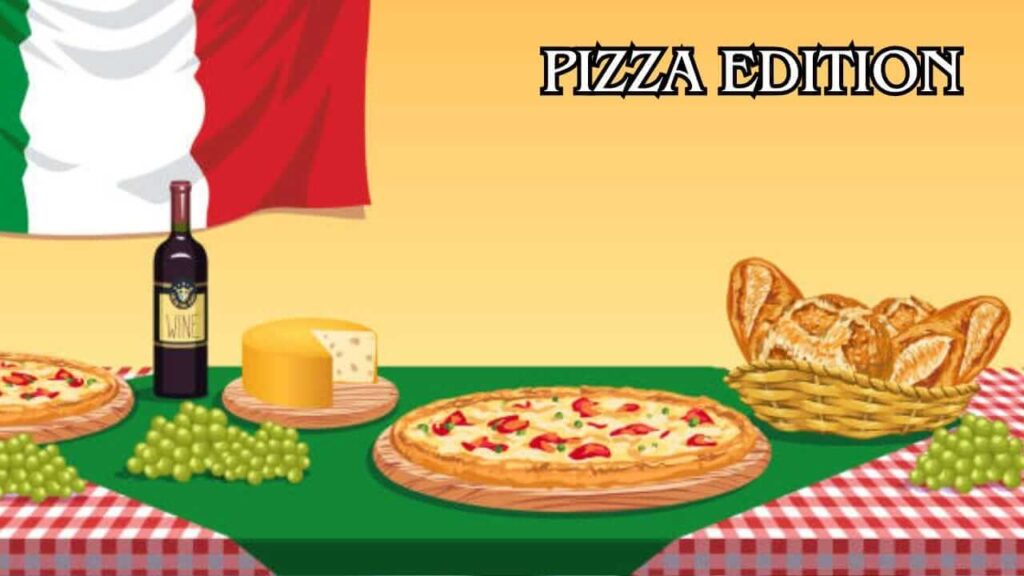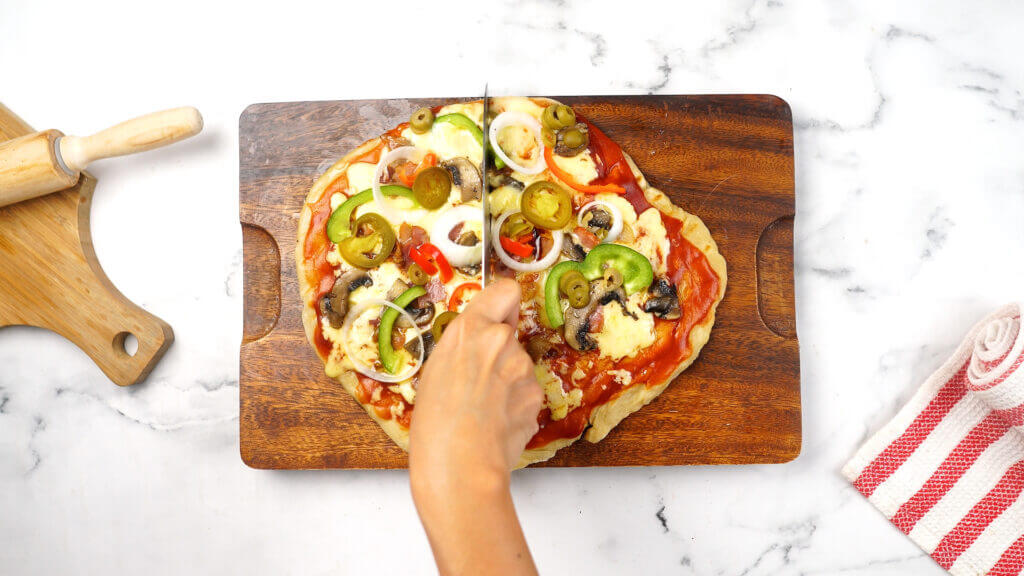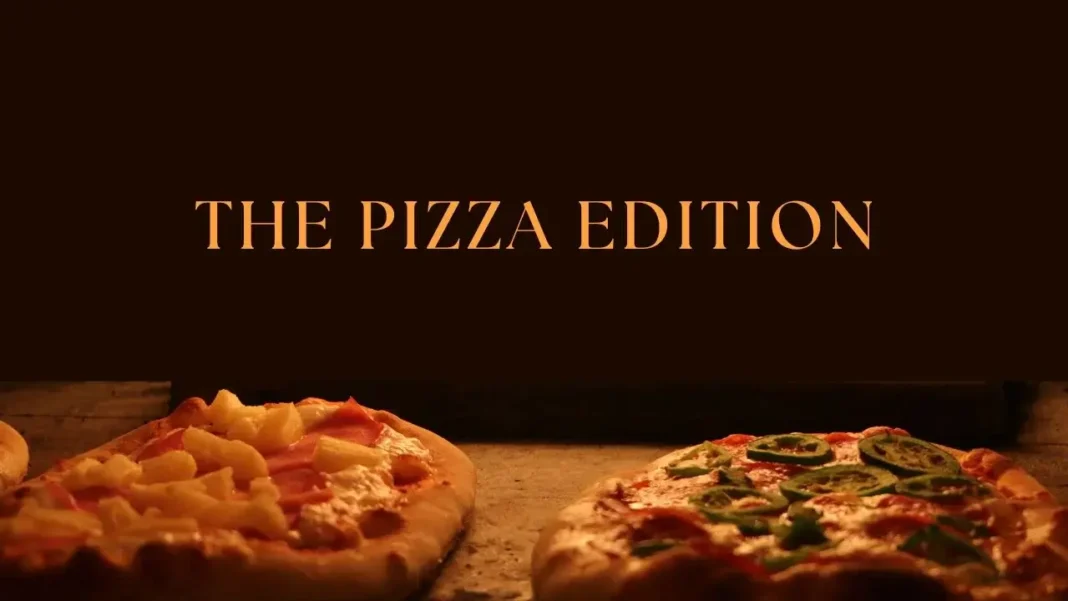Pizza. The word alone can trigger a flood of sensory memories—gooey cheese stretching with every bite, the crispness of a perfectly baked crust, and the rich aroma of tomato sauce and herbs wafting through the air. This iconic dish, once a humble street food in Naples, has transformed into a global phenomenon, beloved by millions and adapted by cultures around the world. From the classic Margherita to extravagant gourmet creations, pizza is more than just a meal; it’s a cultural symbol, a canvas for creativity, and a universal comfort food.
In this edition, we’ll explore the rich history of pizza, its cultural significance, the various styles that have emerged over the years, and the art of making the perfect pie. Whether you’re a die-hard traditionalist or a fan of unconventional toppings, this journey through the world of pizza will leave you craving a slice.
The Origins of Pizza: A Historical Slice
The Ancient Roots
Pizza’s origins can be traced back to ancient civilizations that had their versions of flatbreads topped with various ingredients. The ancient Egyptians, Greeks, and Romans all had a tradition of baking flatbreads, which were often seasoned with herbs and oils. These early forms of pizza were quite different from what we know today, but they laid the groundwork for the modern dish.
The Greeks, for example, baked a flatbread known as “plakous,” which was topped with olive oil, herbs, and cheese. The Romans had “pinsa,” a flatbread similar to modern pizza but made with a different blend of grains and topped with ingredients like dates, honey, and cheese. These ancient flatbreads were primarily eaten by the lower classes, as they were cheap and easy to prepare.
The Birth of the Modern Pizza
The modern pizza, as we know it, originated in Naples, Italy, in the 18th century. Naples, a bustling port city, was home to many working-class citizens who needed affordable, quick, and filling food. Enter the “pizzaiolo,” or pizza maker, who sold simple flatbreads topped with basic ingredients like tomatoes, cheese, and olive oil.
The tomato, a key ingredient in pizza, was introduced to Europe from the Americas in the 16th century. Initially, it was believed to be poisonous, but by the 18th century, it had become a staple in Italian cuisine, particularly in Naples. The combination of tomato, cheese, and dough became the foundation of what would later become pizza.
The Margherita pizza, perhaps the most famous of all, was created in 1889 by a Neapolitan pizzaiolo named Raffaele Esposito. He made it in honor of Queen Margherita of Savoy, who was visiting Naples at the time. The pizza was topped with tomatoes, mozzarella, and basil, representing the colors of the Italian flag—red, white, and green. This pizza was so well-received by the queen that it became known as Pizza Margherita and solidified pizza’s place in Italian culinary history.
The Global Spread of Pizza: From Naples to the World
The American Journey
Pizza made its way to the United States in the late 19th and early 20th centuries with the wave of Italian immigrants who settled in cities like New York, Chicago, and San Francisco. These immigrants brought their culinary traditions with them, including the art of making pizza.
In New York City, pizza first appeared as a street food, sold by the slice to passersby. The first pizzeria in the United States, Lombardi’s, opened in 1905 in Little Italy, Manhattan. Gennaro Lombardi, the founder, is often credited with popularizing pizza in America. His thin-crust, coal-fired pizza became an instant hit and set the standard for what would become known as New York-style pizza.
As pizza spread across the United States, regional variations began to emerge. Chicago gave birth to the deep-dish pizza in the 1940s, characterized by its thick, buttery crust and layers of cheese and toppings. Detroit developed its own style with a rectangular, thick-crust pizza baked in steel pans, resulting in a crispy, caramelized edge. California embraced a more experimental approach, with toppings like goat cheese, arugula, and smoked salmon.
The Global Phenomenon
Pizza’s journey didn’t stop in the United States; it continued to spread across the globe, adapting to local tastes and ingredients. In Japan, you’ll find pizzas topped with ingredients like squid, mayo, and corn. In Brazil, pizzas are often loaded with a wide array of toppings, including catupiry (a creamy cheese), hearts of palm, and even chocolate. In India, you’ll find pizzas with paneer (a type of Indian cheese), tandoori chicken, and spicy curries.
Each country has put its own spin on pizza, making it a truly global dish. Despite these variations, the essence of pizza—a baked flatbread topped with ingredients—remains the same, highlighting its versatility and universal appeal.
The Art of Pizza Making: From Dough to Toppings
Crafting the Perfect Dough
At the heart of every great pizza is the dough. While the toppings and sauce play a significant role, the dough is what truly defines the pizza. The perfect pizza dough should be chewy yet crisp, with just the right amount of rise and flavor.
The basic ingredients for pizza dough are simple: flour, water, yeast, salt, and olive oil. However, the type of flour used can greatly impact the final product. In Italy, “00” flour, a finely milled wheat flour, is often used to create a soft, tender dough. In the United States, bread flour or all-purpose flour is more commonly used, resulting in a slightly chewier crust.
The process of making pizza dough involves mixing the ingredients, kneading the dough to develop the gluten, and allowing it to rise. The rise time is crucial, as it allows the dough to develop flavor and texture. Some pizzaiolos prefer a long, slow fermentation process, allowing the dough to rise for up to 48 hours. This slow rise creates a more complex flavor and a lighter, airier crust.
Once the dough has risen, it is stretched by hand (or rolled out) to the desired thickness. The dough can be shaped into a classic round pizza or a rectangular “pizza al taglio,” popular in Rome. The thickness of the dough varies depending on the style of pizza—thin and crispy for Neapolitan, thick and chewy for Chicago deep-dish, and somewhere in between for New York-style.
The Sauce: A Tomato Lover’s Dream
The tomato sauce is another key component of pizza. A great pizza sauce is rich, tangy, and full of flavor, complementing the dough and toppings without overpowering them.
Traditional Neapolitan pizza sauce is made from San Marzano tomatoes, a variety of plum tomatoes grown in the rich volcanic soil near Mount Vesuvius. These tomatoes are prized for their sweet flavor and low acidity, making them ideal for pizza sauce. The tomatoes are usually crushed by hand, seasoned with a pinch of salt, and spread directly onto the dough without cooking.
In other parts of the world, pizza sauce can vary. Some use a cooked tomato sauce, simmered with garlic, onions, and herbs for a deeper flavor. Others might add a touch of sugar, red pepper flakes, or even anchovies for an extra kick. The choice of sauce can significantly impact the overall taste of the pizza, making it an essential element to get right.

The Cheese: The Melting Magic
When it comes to cheese, mozzarella is the undisputed king of pizza. Its mild flavor, creamy texture, and excellent melting properties make it the perfect choice for topping a pizza. In Italy, fresh mozzarella made from buffalo milk (mozzarella di bufala) is often used, especially in Neapolitan-style pizzas. This cheese has a slightly tangy flavor and a soft, pillowy texture.
In the United States, low-moisture mozzarella is more commonly used, as it has a longer shelf life and a firmer texture that holds up well in the high heat of pizza ovens. Some pizzas, particularly in New York, may also include a sprinkle of grated Parmesan or Pecorino Romano for an extra hit of flavor.
Beyond mozzarella, there are countless other cheeses that can be used on pizza. Provolone, cheddar, fontina, and gorgonzola are just a few examples. In some cases, a blend of cheeses is used to create a more complex flavor profile. The choice of cheese can vary depending on the style of pizza and personal preference.
The Toppings: Endless Possibilities
Toppings are where pizza truly becomes a canvas for creativity. From the classic combination of pepperoni and mushrooms to more unconventional choices like figs and prosciutto, the possibilities are endless.
In traditional Neapolitan pizza, toppings are kept simple to let the quality of the ingredients shine. A classic Margherita might have just tomatoes, mozzarella, and basil, while a Marinara is topped with tomatoes, garlic, and oregano. In contrast, American-style pizzas often feature a wider array of toppings, from pepperoni and sausage to vegetables, seafood, and even pineapple.
When it comes to choosing toppings, balance is key. The toppings should complement each other and the sauce, without overwhelming the dough or turning the pizza into a soggy mess. The order in which the toppings are added can also make a difference—some pizzaiolos prefer to put cheese on first, followed by the toppings, while others do the opposite.
One of the most popular and debated toppings is pepperoni. This spicy, cured sausage became a staple on American pizzas in the mid-20th century and remains the most popular topping in the United States. Other common toppings include mushrooms, onions, bell peppers, olives, and anchovies.
For Those Who Love to Experiment
The art of pizza-making encourages experimentation, and many pizzerias and home cooks alike have taken it to the next level. From exotic ingredients like truffle oil and foie gras to innovative combinations such as barbecue chicken and buffalo sauce, pizza toppings are only limited by one’s imagination.
One standout trend is the gourmet pizza movement, where chefs use high-quality, often artisanal ingredients to create unique flavor profiles. Think of a pizza topped with wild mushrooms, fontina cheese, and a drizzle of white truffle oil. Or perhaps a pie featuring smoked salmon, crème fraîche, and capers, reminiscent of a bagel with lox but on a pizza crust. These gourmet creations showcase how versatile and sophisticated pizza can be, far beyond its humble origins.
Regional Styles of Pizza: A Slice of Local Culture
Neapolitan Pizza: The Classic Italian
Neapolitan pizza, with its thin, tender crust and simple toppings, is the quintessential Italian pizza. Protected by the European Union’s Traditional Specialty Guaranteed (TSG) certification, true Neapolitan pizza must adhere to strict guidelines. It must be baked in a wood-fired oven at a high temperature, using specific ingredients like San Marzano tomatoes, mozzarella di bufala, and fresh basil.
The simplicity of Neapolitan pizza allows each ingredient to shine. The crust is typically light and airy, with a slight char on the edges, while the toppings are fresh and minimal. Variations of Neapolitan pizza include the Margherita, with its classic combination of tomatoes, mozzarella, and basil, and the Marinara, which skips the cheese and focuses on the tomato sauce and garlic.
New York-Style Pizza: A Slice of the Big Apple
New York-style pizza is known for its large, foldable slices and its crisp, yet pliable crust. This style of pizza is characterized by its use of high-gluten bread flour, which gives the dough its chewy texture and allows it to hold up well under a variety of toppings.
New York-style pizza is typically baked in a gas pizza oven, which imparts a distinct flavor and texture to the crust. The pizza is often topped with tomato sauce and mozzarella cheese, with additional toppings like pepperoni, sausage, and mushrooms. The pizza is cut into large, triangular slices, perfect for grabbing on the go.
One of the defining features of New York-style pizza is its ability to be eaten on the street. The crust is thin enough to be folded in half, making it easy to eat while walking. This practical design has made New York-style pizza a staple of the city’s fast-paced lifestyle.
Chicago Deep-Dish Pizza: A Hearty Slice
Chicago deep-dish pizza is a substantial departure from its thin-crust counterparts. This style of pizza is known for its thick, buttery crust and its layers of cheese, toppings, and chunky tomato sauce. The pizza is baked in a deep, round pan, which gives it its characteristic height and allows for a generous filling.
The process of making Chicago deep-dish pizza involves layering cheese directly on the dough, followed by toppings and then a thick tomato sauce. The result is a pizza that is more like a pie, with a rich, hearty flavor and a satisfying texture. Popular toppings include sausage, pepperoni, green peppers, and onions.
Chicago deep-dish pizza is a meal in itself, and its robust flavors make it a favorite among those looking for a substantial, comforting dish. Despite its heaviness, it’s often enjoyed with a side salad or some garlic bread to balance out the richness.
Detroit-Style Pizza: A Square Deal
Detroit-style pizza is a relatively new player in the pizza world but has quickly gained popularity for its unique shape and flavor. This style of pizza is baked in a rectangular pan, resulting in a square or rectangular pie with a crispy, caramelized crust.
Detroit-style pizza features a thick, airy crust that is topped with cheese, often spread all the way to the edges of the pan. This creates a delicious, crispy cheese crust as it bakes. The pizza is typically topped with pepperoni and a chunky tomato sauce that is spread over the top of the cheese and toppings.
The square shape of Detroit-style pizza is a nod to the automotive history of Detroit, where the rectangular pans used for baking were originally parts trays for car parts. This style of pizza has become known for its distinctive texture and rich, savory flavors.

California-Style Pizza: A Fresh Take
California-style pizza is known for its innovative use of fresh, often unconventional ingredients. This style of pizza emphasizes fresh produce, lean meats, and gourmet toppings, reflecting the diverse culinary influences of California.
California-style pizza often features toppings like goat cheese, sun-dried tomatoes, artichoke hearts, and smoked salmon. The crust is typically thin and crisp, allowing the toppings to shine without overwhelming the dish. This style of pizza is a testament to the creativity and health-conscious mindset of the California culinary scene.
The Science of Baking Pizza: Achieving the Perfect Crust
The Role of Temperature
One of the most critical factors in baking pizza is temperature. A high baking temperature is essential for achieving a crispy, well-cooked crust. Traditional wood-fired pizza ovens reach temperatures of around 800-900°F (427-482°C), allowing the pizza to cook quickly and develop a distinctive charred flavor.
For home ovens, a temperature of 475-500°F (246-260°C) is typically recommended. Preheating the oven and using a pizza stone or steel can help mimic the effects of a wood-fired oven, creating a similar crispy crust.
The Importance of Time
Baking time is another crucial factor in pizza-making. The pizza should be baked until the crust is golden brown and the cheese is melted and bubbly. Overcooking can lead to a dry, tough crust, while undercooking can result in a soggy, raw center.
Using a pizza peel to transfer the pizza to and from the oven can help ensure even baking and prevent sticking. It’s also important to monitor the pizza closely during the baking process, as oven temperatures can vary.
The Impact of Ingredients
The quality of the ingredients used in pizza-making can greatly impact the final product. Fresh, high-quality tomatoes, cheese, and toppings will all contribute to a more flavorful and satisfying pizza. Using high-quality flour for the dough and fresh yeast can also enhance the texture and flavor of the crust.
Pizza Culture: A Global Community
Pizza and Social Gatherings
Pizza is more than just food; it’s a social experience. Sharing a pizza with friends and family is a time-honored tradition, and many people associate pizza with celebrations, parties, and casual get-togethers. The pizza parlor, or pizzeria, has become a community gathering spot where people can enjoy good food and company in a relaxed setting.
In Italy, pizza is often enjoyed in a leisurely manner, with families and friends gathering around the table to savor each slice. The act of eating pizza is as much about the social experience as it is about the food itself. In the United States, pizza parties and pizza nights are common, with people coming together to share their favorite pies and enjoy each other’s company.
The Future of Pizza
As pizza continues to evolve, it’s clear that it will remain a beloved part of global cuisine. New trends, such as plant-based pizzas and alternative crust options, reflect changing tastes and dietary preferences. Pizzerias and home cooks alike are constantly experimenting with new ingredients, techniques, and flavor combinations, ensuring that pizza will continue to surprise and delight.
The future of pizza is likely to see a continued focus on sustainability, with an emphasis on locally sourced ingredients and eco-friendly practices. As the global community embraces new culinary trends and innovations, pizza will undoubtedly remain at the forefront, celebrating its rich history while looking forward to new possibilities.
Conclusion
Pizza is more than just a meal—it’s a cultural icon, a canvas for creativity, and a symbol of shared experiences. From its humble beginnings in Naples to its status as a global phenomenon, pizza has captured the hearts and taste buds of people around the world. Whether you prefer a classic Margherita, a hearty Chicago deep-dish, or an inventive California-style creation, there’s a pizza out there for everyone.
As we explore the diverse world of pizza, we gain a deeper appreciation for its history, its cultural significance, and its endless possibilities. So next time you enjoy a slice, take a moment to savor not just the flavors but the journey that brought this beloved dish to your plate.
